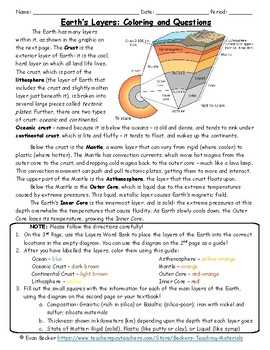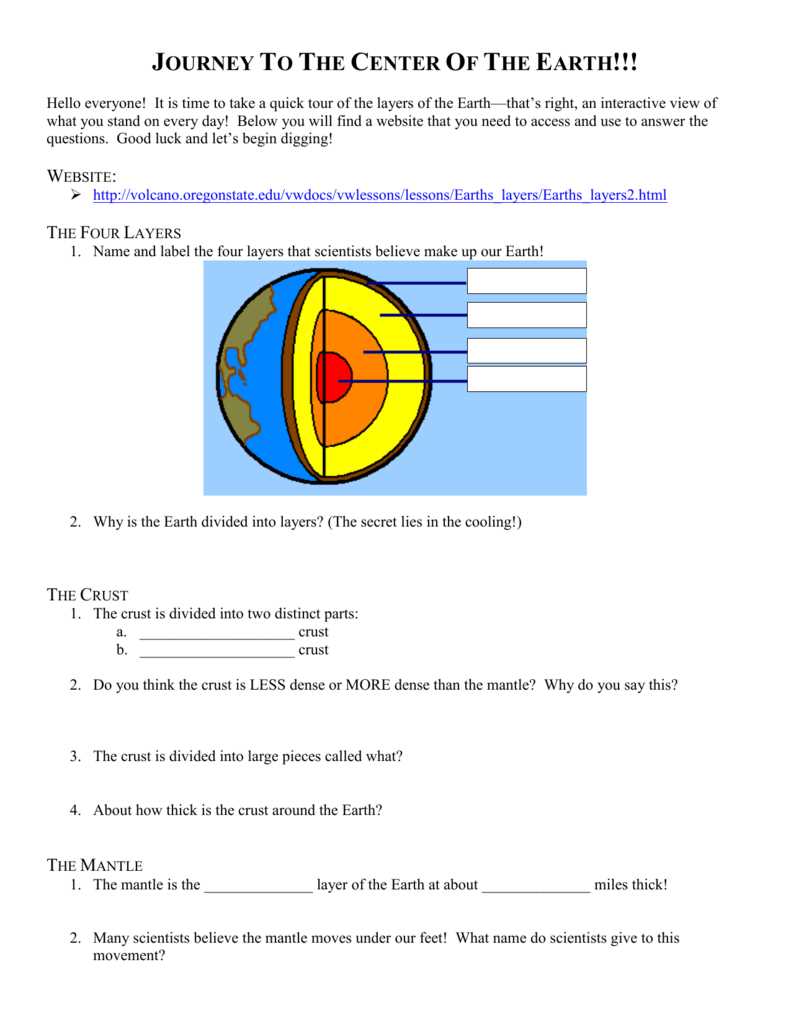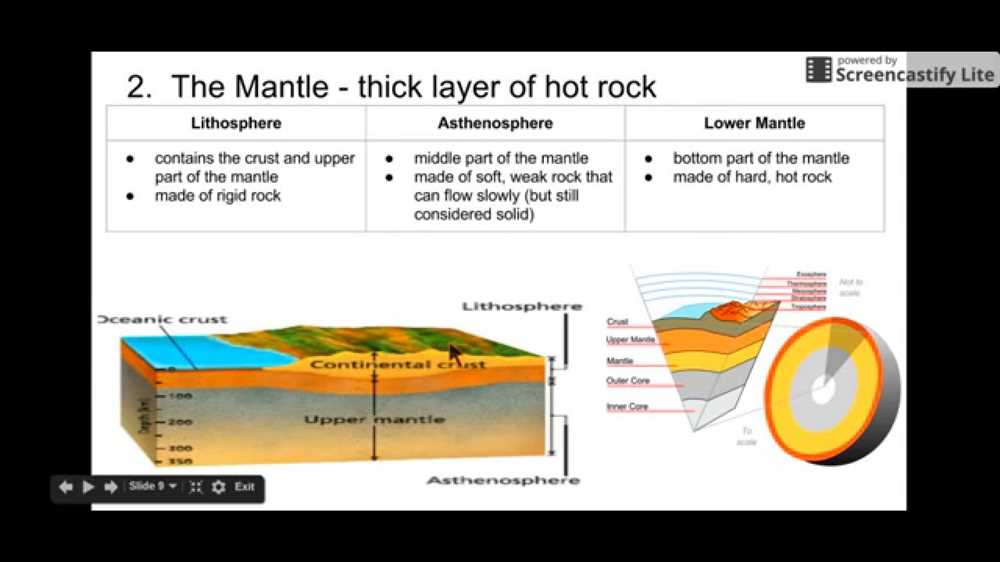
Understanding the layers of the Earth is crucial to understanding the dynamics of our planet. The Earth is composed of several layers, each with its own unique properties and characteristics. By creating a foldable to explore these layers, students can gain a deeper understanding of the Earth’s structure and how it affects our lives.
The first layer, known as the crust, is the outermost layer of the Earth. It is composed of solid rock and is divided into two types: continental and oceanic crust. Continental crust is thicker and less dense than oceanic crust, and it makes up the landmasses that we live on. Oceanic crust, on the other hand, is thinner and more dense, and it forms the ocean floor. Both types of crust are constantly moving and changing due to plate tectonics.
Beneath the crust is the mantle, which is the largest layer of the Earth. The mantle is composed of solid rock, but it has the ability to flow slowly over long periods of time. This flow is responsible for the movement of the tectonic plates and the formation of mountains, volcanoes, and earthquakes. The uppermost part of the mantle, known as the asthenosphere, is especially important for plate tectonics as it is partially molten and allows the plates to move.
The innermost layer of the Earth is the core, which is divided into two parts: the outer core and the inner core. The outer core is made up of liquid iron and nickel, while the inner core is solid due to the immense pressure at the center of the Earth. The core plays a crucial role in generating the Earth’s magnetic field, which protects our planet from harmful solar radiation.
By creating a foldable that explores these layers, students can visualize and understand the different components of the Earth. This hands-on activity allows them to engage with the material and make connections between the layers and various geological phenomena. It also helps reinforce the idea that the Earth is a complex and dynamic system that is constantly changing.
What is Earth Layers Foldable?
An Earth Layers Foldable is an interactive educational tool used to visually represent and organize information about the layers of the Earth. It is typically created by folding a piece of paper or cardstock in a way that allows for different layers to be displayed and accessed. This foldable provides a hands-on approach to learning about the Earth’s composition and structure, making it an effective tool for students of all ages.
The Earth is composed of several distinct layers, including the crust, mantle, outer core, and inner core. Each layer has its own unique properties and characteristics. The Earth Layers Foldable allows students to explore these layers individually by providing designated sections or compartments for each layer.
- The outermost layer, the crust, is represented on the foldable’s surface and typically contains information about its thickness, composition, and types (continental and oceanic).
- As the foldable is opened, the next layer, the mantle, is revealed. This layer is much thicker than the crust and is composed of solid rock that can flow slowly over long periods of time.
- The foldable continues to unfold, exposing the third layer, the outer core. This layer consists of liquid iron and nickel and is responsible for generating the Earth’s magnetic field.
- Finally, the last layer, the inner core, is revealed. It is the Earth’s innermost layer and is composed of solid iron and nickel due to the extreme pressure at the center of the planet.
The Earth Layers Foldable provides a clear and organized visual representation of the Earth’s layers, allowing students to grasp the concept more easily. It also encourages active participation and engagement, as students can personalize and fill in information about each layer. Overall, the Earth Layers Foldable is a valuable tool for teaching and learning about the structure and composition of our planet.
Importance of Earth Layers Foldable Answers
The Earth is composed of several layers that play a crucial role in shaping its structure and influencing the processes that occur on its surface. Understanding the different layers of the Earth is essential for various fields of study, including geology, meteorology, and environmental science. Therefore, having accurate and comprehensive answers in an Earth layers foldable is of great importance.
An Earth layers foldable provides a concise and organized way to present information about the Earth’s layers. By clearly labeling and detailing each layer, it allows students and researchers to quickly access vital information about the Earth’s composition and characteristics. This not only helps in memorizing the different layers but also aids in understanding how they interact and affect the planet as a whole.
A well-designed Earth layers foldable answers sheet can also serve as a valuable reference tool. It allows students to review the information they have learned and reinforces their knowledge of the Earth’s layers. When studying or conducting research, having an easily accessible resource like a foldable answers sheet can save time and effort in searching for information from different sources.
Furthermore, an Earth layers foldable answers sheet encourages active learning and engagement. By creating their own foldable answers, students become active participants in the learning process. They have to critically analyze and synthesize information about the Earth’s layers to create a coherent and accurate foldable. This process enhances their understanding and retention of the subject matter.
In conclusion, an Earth layers foldable answers sheet is essential in providing a comprehensive and organized representation of the Earth’s layers. It serves as a valuable reference tool, aids in understanding the Earth’s composition and characteristics, and promotes active learning. Having accurate and informative answers in an Earth layers foldable is crucial for students and researchers in various fields of study related to the Earth’s geology and structure.
Understanding Earth Layers

The Earth is composed of several distinct layers, each with its own unique properties and characteristics. By understanding these layers, scientists have been able to gain valuable insights into the structure and composition of our planet.
The Crust
The outermost layer of the Earth is called the crust. It is the thinnest and coolest layer, ranging in thickness from about 5 to 70 kilometers. The crust is composed of solid rocks and is further divided into two types: the continental crust, which is thicker and less dense, and the oceanic crust, which is thinner and more dense. The crust is constantly being formed and destroyed through processes such as volcanic activity and plate tectonics.
The Mantle

Beneath the crust lies the mantle, which extends to a depth of about 2,900 kilometers. The mantle is composed of solid rock that is capable of flowing over long periods of time, similar to the consistency of hot tar. This layer is further divided into the upper mantle and the lower mantle. The upper mantle is less rigid and more elastic, while the lower mantle is denser and more rigid. The mantle plays a crucial role in the Earth’s heat budget and convective processes that drive plate tectonics.
The Core

The innermost layer of the Earth is known as the core. It is divided into two parts: the outer core and the inner core. The outer core is primarily composed of liquid iron and nickel, while the inner core is a solid sphere of extremely high pressure and temperature. The core is responsible for generating the Earth’s magnetic field, as well as providing the energy that drives volcanic activity and plate tectonics.
Overall, the Earth’s layers work together to create a dynamic and ever-changing planet. Through studying these layers, scientists have been able to unravel the mysteries of our planet’s past, present, and future.
What are Earth Layers?
The Earth is composed of several layers that make up its structure. These layers, known as the Earth’s geosphere, extend from the surface all the way to the planet’s core. Each layer has distinct characteristics and plays a crucial role in shaping the Earth’s dynamics and geological processes.
The first layer of the Earth is called the crust. It is the outermost layer and is composed of solid rock, soil, and water. The crust can be divided into two types: continental crust, which forms the continents, and oceanic crust, which underlies the ocean basins. The thickness of the crust varies, with the continental crust being thicker than the oceanic crust.
Beneath the crust lies the second layer, known as the mantle. The mantle is primarily made up of solid rock, but it also contains pockets of molten rock called magma. This layer is responsible for the movement of tectonic plates, which causes earthquakes, volcanic activity, and the creation of mountain ranges. The mantle extends all the way down to the Earth’s core, making it the thickest layer.
The third and innermost layer of the Earth is the core. It is divided into two parts: the outer core and the inner core. The outer core is comprised of liquid iron and nickel, while the inner core is solid. The core plays a crucial role in generating the Earth’s magnetic field, which protects our planet from harmful solar radiation.
In summary, the Earth is comprised of several layers, including the crust, mantle, and core. These layers interact with each other, giving rise to the Earth’s natural phenomena and sustaining life on our planet.
Composition of Earth’s Layers
The Earth is composed of several layers, each with its own unique characteristics and properties. These layers, from innermost to outermost, include the inner core, outer core, mantle, and crust.
The inner core is the Earth’s innermost layer and is primarily made up of solid iron and nickel. It is estimated to have a radius of about 1,220 kilometers. The immense pressure at the center of the Earth keeps the inner core in a solid state, despite its extremely high temperature. Scientists believe that the inner core’s temperature can reach up to 6,000 degrees Celsius.
The outer core, surrounding the inner core, is composed of molten iron and nickel. This layer is responsible for generating Earth’s magnetic field through the process of convection. The temperature in the outer core is slightly lower than that of the inner core, ranging from 4,400 to 5,500 degrees Celsius.
The mantle is the largest layer of the Earth and is primarily composed of solid rock. It is divided into two parts: the upper mantle and the lower mantle. The upper mantle is solid but can undergo slow, plastic-like flow. The lower mantle, on the other hand, is under immense pressure and is more rigid. The mantle is responsible for convection currents, which drive the movement of tectonic plates on the Earth’s surface.
The outermost layer of the Earth is the crust, which is the thinnest layer but extremely important for life on Earth. The crust is composed of a mixture of solid rocks, minerals, and soil. There are two types of crust: the continental crust, which forms the continents, and the oceanic crust, which forms the ocean basins.
In summary, the Earth’s layers consist of the inner core, outer core, mantle, and crust. Each layer has its own composition and plays a crucial role in shaping the Earth’s geology and supporting life on our planet.
The Crust: Earth’s Outer Layer
The crust is the outermost layer of the Earth’s surface. It is a relatively thin layer compared to the other layers of the Earth, with an average thickness of about 35 kilometers. The crust is made up of solid rock and soil, forming the foundation for the Earth’s landscapes and supporting all life forms on the planet.
There are two types of crust: continental crust and oceanic crust. Continental crust is found beneath the continents and is composed mainly of granitic rocks. It is thicker and less dense than oceanic crust. Oceanic crust, on the other hand, is found beneath the ocean basins and is composed mainly of basaltic rocks. It is thinner and denser than continental crust.
- Continental crust:
- Made up of granitic rocks
- Thicker and less dense than oceanic crust
- Mainly found beneath continents
- Oceanic crust:
- Made up of basaltic rocks
- Thinner and denser than continental crust
- Mainly found beneath ocean basins
The crust is divided into several large and small tectonic plates, which float on the semi-fluid layer below called the mantle. These plates are constantly moving, colliding, and interacting with each other, leading to various geological activities such as earthquakes, volcanic eruptions, and the formation of mountain ranges. It is on the Earth’s crust where we find features like continents, oceans, mountains, and valleys, shaping the physical characteristics of our planet.
Understanding the Earth’s crust is essential for scientists to study the geological processes happening on our planet and to gain insight into the history and evolution of Earth. It also plays a vital role in human activities, as it contains valuable resources such as minerals, fossil fuels, and groundwater, which are essential for our modern civilization.
Features of the Crust

The crust is the outermost layer of the Earth and is made up of various features that define its composition and structure. These features include the continents, ocean basins, and tectonic plates.
Continents: The crust is divided into several large land masses known as continents. These include North America, South America, Africa, Europe, Asia, Australia, and Antarctica. The continents are mainly made up of granite rocks, which are light-colored and have a lower density compared to the oceanic crust.
Ocean Basins: In contrast to the continents, the crust beneath the ocean is known as oceanic crust. It consists mostly of basalt rocks, which are dark-colored and have a higher density compared to granite. Ocean basins cover about two-thirds of the Earth’s surface and are characterized by deep trenches, underwater mountain ranges, and volcanic activity.
Tectonic Plates: The Earth’s crust is divided into several large and smaller tectonic plates. These plates are constantly moving and interacting with each other, resulting in various geological phenomena such as earthquakes, volcanic eruptions, and the formation of mountain ranges. The movement of these plates is driven by the convection currents in the underlying mantle.
Overall, the crust is a complex and dynamic layer of the Earth, with its features playing a crucial role in shaping the planet’s surface and influencing geological processes. Understanding the characteristics and behavior of the crust is essential for studying the Earth’s history, predicting natural disasters, and exploring its resources.